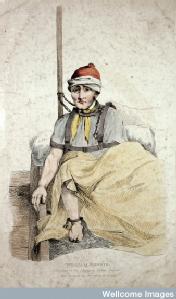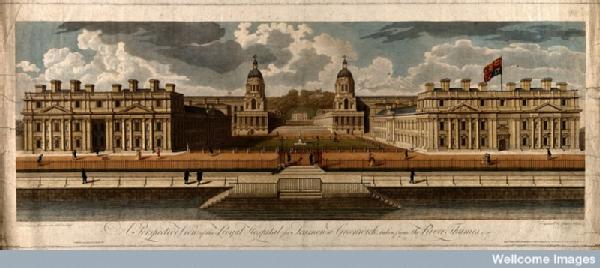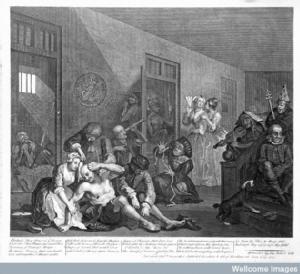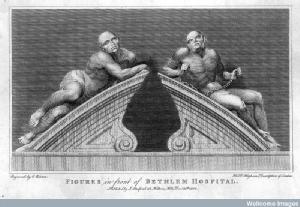Mind Forg'd Manacles: Madness in the 18th Century
TOPIC 2 (WEEK 3): INTRODUCTION
QUESTIONS
|
READING
|
BETHLEM HOSPITAL You might want to start preparing for this seminar by listening to the podcast of 'In Our Time', on Bedlam, with Jonathan Andrews, Justin Champion and myself debating the rights and wrongs of Bethlem Hospital: https://www.bbc.co.uk/programmes/b006qykl/topics/Bethlem_Royal_Hospital ** Jonathan Andrews, ‘Hardly a Hospital, but a Charity for Pauper Lunatics’? Therapeutics at Bethlem in the Seventeenth and Eighteenth Centuries’, in Jonathan Barry and Colin Jones (eds), Medicine and Charity Before the Welfare State (London and New York: Routledge, 1991), pp. 63-81. e-book ** Jonathan Andrews et al., The History of Bethlem (London and New York: Routledge, 1997), chs. 18 ‘Admission and Discharge’ and 19 ‘The Politics of Committal to Early Modern Bethlem’, pp. 315-47, 348-62. e-book * Jonathan Andrews, ‘The Politics of Committal to Early Modern Bethlem’, in Roy Porter (ed.), Medicine in the Enlightenment (Amsterdam and Atlanta, GA: Rodopi, 1995), pp. 6-63. Multiple copies in library * Andrew Scull, Charlotte MacKenzie and Nicholas Hervey, Masters of Bedlam: The Transformation of the Mad-Doctoring Trade (Princeton University Press, 1996), ch. 2 ‘A Bethlematical Mad-Doctor: John Haslam (1764-1866)’, pp. 10-47. (this volume has other useful case studies of key figures in psychiatry). Multiple copies in library and e-book ** Patricia Allderidge, ‘Management and Mismanagement at Bedlam, 1547-1633’, in Charles Webster (ed.), Health, Medicine and Mortality in the Sixteenth Century (Cambridge University Press, 1979), pp. 141-64. Chapter scanned (course extracts HI383) and available via Talis Aspire Patricia Allderidge, ‘Bedlam: Fact or Fantasy?’, Anatomy of Madness I, pp. 17-33. Patricia Allderidge, ‘Sketches in Bedlam’, in Leonie de Goei and Joost Vijselaar (eds), Proceedings: 1st European Congress on the History of Psychiatry and Mental Health Care (Rotterdam: Erasmus Publishing, 1993), pp. 76-82. |
 |
|
|
MADNESS IN THE 18th CENTURY
KEY READING:
** Michael MacDonald, ‘Religion, Social Change and Psychological Healing in England 1600-1800’, in W. Sheils (ed.), The Church and Healing (Oxford: Basil Blackwell, 1982), pp. 101-26. Chapter scanned and available via Talis Aspire
** Michael MacDonald, ‘Insanity and the Realities of History in Early Modern England’, Psychological Medicine, 11 (1981), 11-25. e-journal
** Peter Elmer and Ole Peter Grell (eds), Health, Disease and Society in Europe 1500-1800: A Source Book (Manchester University Press, with the Open University, 2004), Part 9 ‘The Care and Cure of the Insane in Early Modern Europe’, pp. 231-41 on Richard Napier. Multiple copies in library and available via Talis Aspire
** Roy Porter, Mind-Forg’d Manacles: A History of Madness in England from the Restoration to the Regency (London: Athlone, 1987; Penguin edn, 1990), especially chs. 2 and 3. Multiple copies in library and e-book
FURTHER READING:
** Michael MacDonald, Mystical Bedlam: Madness, Anxiety and Healing in Seventeenth Century England (Cambridge: Cambridge University Press, 1981).
* Roy Porter, Madmen: A Social History of Madhouses, Mad-Doctors and Lunatics (Stroud: Tempus, 2004).
** Akihito Suzuki, ‘Anti-Lockean Enlightenment? Mind and Body in Early Eighteenth-Century English Medicine’, in Roy Porter (ed.), Medicine in the Enlightenment (Amsterdam and Atlanta, GA: Rodopi, 1995), pp. 336-59. Chapter scanned and available via Talis Aspire
* George Rosen, ‘Social Attitudes to Irrationality and Madness in Seventeenth- and Eighteenth-Century Europe’, Journal of the History of Medicine, 18 (1963), 220-40. e-journal
* Leonard Smith, Lunatic Hospitals in Georgian England, 1750-1830 (London and New York: Routledge, 2007). e-book
* Jonathan Andrews and Andrew Scull, Customers and Patrons of the Mad Trade: The Management of Lunacy in Eighteenth-Century London (University of California Press, 2003). e-book
* Jonathan Andrews and Andrew Scull, Undertaker of the Mind: John Munro and Mad-Doctoring in Eighteenth-Century England (University of California Press, 2001).
* Akihito Suzuki, ‘Dualism and the Transformation of Psychiatric Language in the Seventeenth and Eighteenth Centuries’, History of Science, 33 (1995), 417-47. e-journal
Rab Houston, Madness and Society in Eighteenth-Century Scotland (Oxford: Clarendon Press, 2000). e-book
Jeremy Schmidt, Melancholy and the Care of the Soul: Religion, Moral Philosophy and Madness in Early Modern England (Aldershot: Ashgate, 2007). e-book
Katharine Hodgkin, Madness in Seventeenth-Century Autobiography (Houndmills: Palgrave, 2007). e-book
Jonathan Andrews, ‘The Lot of the “Incurably” Insane in Enlightenment England’, Eighteenth-Century Life, 12 (1988), 3-18. Available via Talis Aspire
Allan Ingram (ed.), Patterns of Madness in the Eighteenth Century: A Reader (Liverpool University Press, 1998). Several copies in library
Allan Ingram et al., Melancholy Experience in Literature of the Long Eighteenth Century: Before Depression 1660-1800 (Basingstoke: Palgrave Macmillan, 2011). e-book
Allan Ingram, Cultural Constructions of Madness in Eighteenth-Century Writing: Representing the Insane (Houndmills: Palgrave Macmillan, 2005). e-book
Vieda Skultans, English Madness: Ideas on Insanity 1580-1890 (London: Routledge & Kegan Paul, 1979), ch. 3 ‘The English Malady’.
Michael MacDonald, ‘Lunatics and the State in Georgian England’, Social History of Medicine, 2 (1989), 299-319. e-journal
Roy Porter, ‘The Rage of Party: A Glorious Revolution in English Psychiatry?’, Medical History, 27 (1983), 35-50. e-journal
George Rosen, Madness in Society: Chapters in the Historical Sociology of Mental Illness (London: Routledge & Kegan Paul, 1968).
Akihito Suzuki, ‘Lunacy in Seventeenth- and Eighteenth-Century England: Analysis of Quarter Sessions Records’, Parts I and II, History of Psychiatry, 2 (1991), 437-56; 3 (1992), 29-44. e-journal
Max Byrd, Visits to Bedlam: Madness and Literature in the Eighteenth Century (University of South Carolina Press, 1974).
William Battie, MD, A Treatise on Madness and Remarks on Dr. Battie's Treatise on Madness, introduced by Richard Hunter and Ida Macalpine (1758, London: Dawsons of Pall Mall, 1962).
Roy Porter, ‘Love, Sex, and Madness in Eighteenth-Century England’, Social Research, 53 (1986), 211-42. e-journal
Jonathan Andrews, ‘”In Her Vapours… [or] in her Madness”? Mrs Clarke’s Case: An Early Eighteenth Century Psychiatric Controversy’, History of Psychiatry, 1 (1990), 125-44. e-journal
Colin Jones, The Charitable Imperative: Hospitals and Nursing in Ancien Regime and Revolutionary France (London and New York: Routledge, 1989), ch. 8 ‘The PreHistory of the Lunatic Asylum in Provincial France: The Treatment of the Insane in Eighteenth- and Early Nineteenth-Century Montpellier’, pp. 275-304.
Dora B. Weiner, ‘The Brothers of Charity and the Mentally Ill in Pre-Revolutionary France’, Social History of Medicine, 2 (1989), 321-37. e-journal
Larry D. Eldridge, ‘”Crazy Brained”: Mental Illness in Colonial America’, Bulletin of the History of Medicine, 70 (1996), 361-86. e-journal
David J. Rothman, The Discovery of the Asylum: Social Order and Disorder in the New Republic (Boston: Little, Brown, 1990).
Mary Ann Jimenez, ‘Madness in Early American History: Insanity in Massachusetts from 1700 to 1830’, Journal of Social History, 20 (1984), 25-44. e-journal



